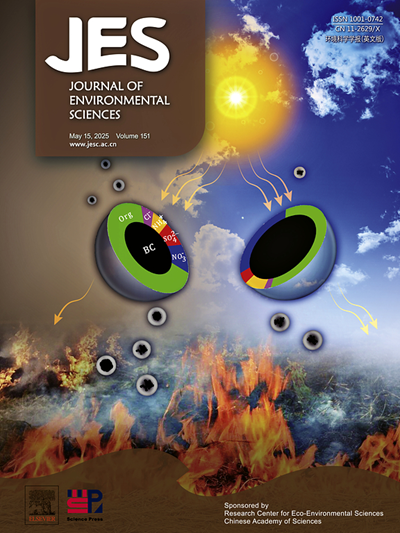Exposure to plasticizers in city waste recycling: Focused on the size-fractioned particulate-bound phthalates and bisphenols
IF 5.9
2区 环境科学与生态学
Q1 ENVIRONMENTAL SCIENCES
引用次数: 0
Abstract
Phthalate (PAEs) and Bisphenols (BPs) are plasticizers or additives in consumer products. They are typical endocrine disruptors, and potential health hazards may occur when people are exposed to them through inhalation, ingestion, and dermal contact. The current research on inhalation exposure pays limited attention to the particle distribution of PAEs and BPs in air, although particulate-bound pollutants are usually size-dependent. In this study, we discussed the size resolution of PAEs and BPs in air particles from city waste recycling plants. With paired urine samples of the workers, we also compared the internal and external exposure of PAEs and BPs and related potential health risks. The particulate-bound PAEs and BPs concentrated mainly on coarse particles (Dp > 2.1 µm), with a bimodal distribution, and the peak particle size ranged from 9–10 to 4.7–5.85 µm, respectively. Model calculation revealed that the deposition fluxes of PAEs in different respiratory regions followed the sequence of head airways (167±92.8 ng/h) > alveolar region (18.9 ± 9.96 ng/h) > tracheobronchial region (9.20±5.22 ng/h), and the similar trends went for BPs. The daily intakes of PAEs and BPs via dust ingestion were higher than those from respiratory inhalation and dermal contact, with mean value of 96 and 0.88 ng/(kg-bw day), respectively. For internal exposure, the estimated daily intakes of PAEs for waste recycling workers were higher than those in e-waste dismantling workers, while the exposure levels of bisphenols were comparable. Overall, the potential health risks from inhalation exposure to particulate-bound PAEs and BPs were low.
城市垃圾回收中增塑剂的暴露:重点关注大小分级颗粒结合的邻苯二甲酸盐和双酚
邻苯二甲酸酯(PAEs)和双酚(bp)是消费品中的增塑剂或添加剂。它们是典型的内分泌干扰物,当人们通过吸入、摄入和皮肤接触接触到它们时,可能会产生潜在的健康危害。目前对吸入暴露的研究对空气中PAEs和bp的颗粒分布关注有限,尽管颗粒结合的污染物通常与大小有关。在这项研究中,我们讨论了PAEs和bp在城市垃圾回收厂的空气颗粒的大小分辨率。通过配对的工人尿液样本,我们还比较了PAEs和bp的内部和外部暴露以及相关的潜在健康风险。颗粒结合PAEs和bp主要集中在粗颗粒(Dp >;2.1µm),呈双峰分布,峰值粒径范围分别为9 ~ 10 ~ 4.7 ~ 5.85µm。模型计算表明,PAEs在不同呼吸区域的沉积通量依次为头部气道(167±92.8 ng/h) >;肺泡区(18.9±9.96 ng/h) >;气管支气管区(9.20±5.22 ng/h),血压变化趋势相似。通过吸尘方式摄入PAEs和bp的平均值分别为96 ng/(kg-bw d)和0.88 ng/(kg-bw d),高于呼吸吸入和皮肤接触。就内部暴露而言,废物回收工人的PAEs每日摄入量估计高于电子废物拆解工人,而双酚的暴露水平相当。总体而言,吸入接触颗粒结合PAEs和bp的潜在健康风险较低。
本文章由计算机程序翻译,如有差异,请以英文原文为准。
求助全文
约1分钟内获得全文
求助全文
来源期刊

Journal of Environmental Sciences-china
环境科学-环境科学
CiteScore
13.70
自引率
0.00%
发文量
6354
审稿时长
2.6 months
期刊介绍:
The Journal of Environmental Sciences is an international journal started in 1989. The journal is devoted to publish original, peer-reviewed research papers on main aspects of environmental sciences, such as environmental chemistry, environmental biology, ecology, geosciences and environmental physics. Appropriate subjects include basic and applied research on atmospheric, terrestrial and aquatic environments, pollution control and abatement technology, conservation of natural resources, environmental health and toxicology. Announcements of international environmental science meetings and other recent information are also included.
 求助内容:
求助内容: 应助结果提醒方式:
应助结果提醒方式:


